Yielding profound insights, the death and resurrection of Jesus in the Bible embodies divine mysteries—discover what lies beyond the empty tomb.
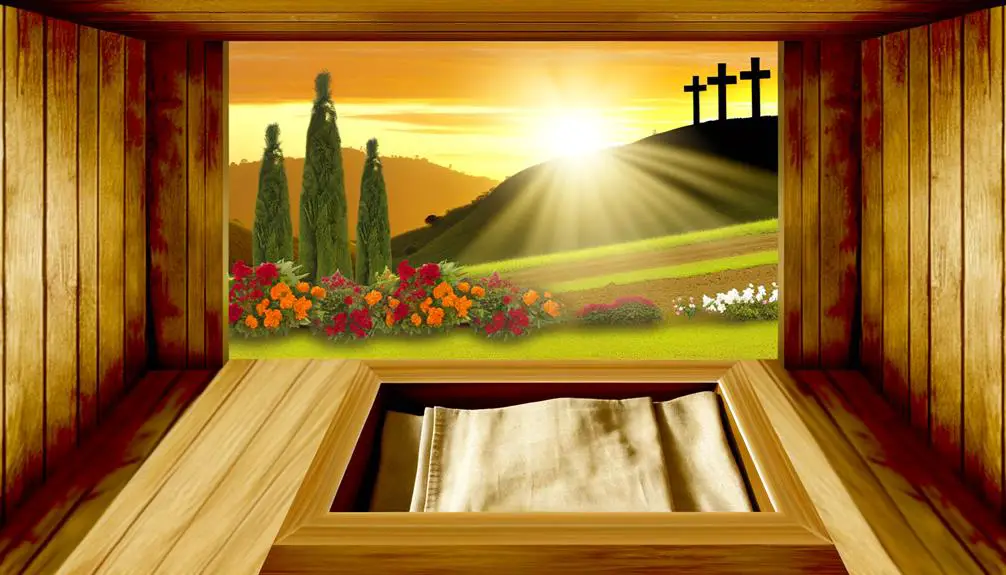
Death and Resurrection of Jesus in the Bible
In the Bible, you'll find the crucifixion of Jesus at Golgotha, a poignant reflection of his challenge to Roman authority and fulfillment of Jewish prophecies, such as those in Isaiah 53 and Psalm 22. His death isn't merely an event—it's a theological cornerstone that affirms his messianic identity. Following his crucifixion, Jesus's burial and the architectural nuances of the tomb underscore his resurrection. When Mary Magdalene and others witness the risen Christ, it's not only a miraculous event but firmly rooted in empirical evidence. These accounts offer layers of meaning that reveal the depth of divine interaction through Christ's life and beyond.
Key Takeaways
- Crucifixion of Jesus at Golgotha fulfilled Old Testament prophecies, affirming his messianic role.
- Events like the Last Supper and Judas's betrayal were pivotal in leading to Jesus's crucifixion.
- Symbolic and physical aspects of the tomb highlight Jesus's resurrection as a foundational Christian belief.
- Post-resurrection appearances to figures like Mary Magdalene and Paul underscore the reality of Jesus's return from death.
- The resurrection validates theological claims of Jesus as the mediator and redeemer in Christian faith.
Biblical Accounts of Crucifixion
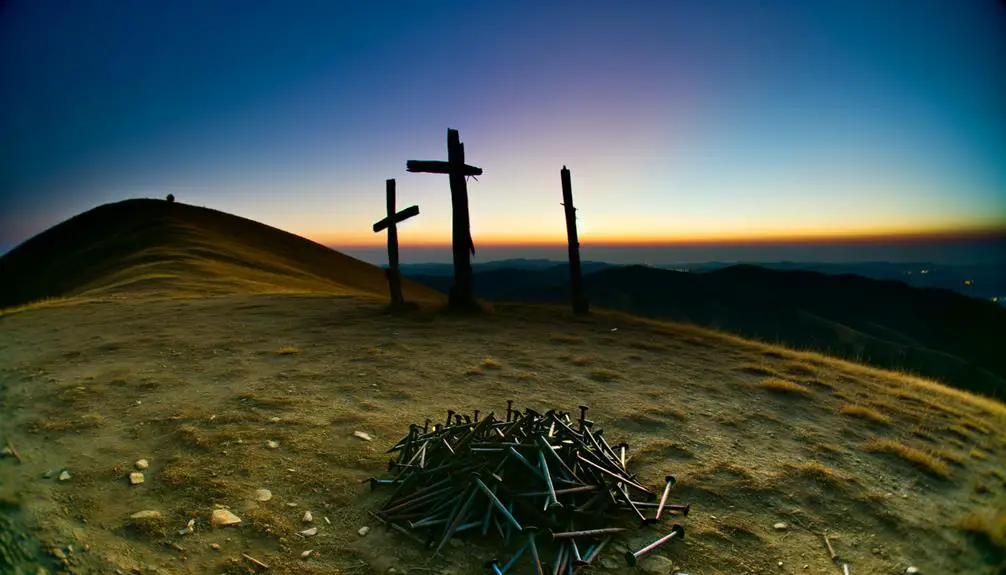
The crucifixion of Jesus, as narrated in the New Scriptures, isn't just a historical event, but a pivotal moment that's been analyzed for its theological implications and historical context. To truly understand its significance, you need to explore the Roman practices and crucifixion methods prevalent at the time.
Crucifixion was a brutal method of execution used by Romans, primarily reserved for slaves, revolutionaries, and the worst criminals. The procedure was designed to be as painful and prolonged as possible, serving as a deterrent through public humiliation. Victims were typically flogged before being nailed or tied to a cross, where they would hang until exhaustion and asphyxiation took hold.
In the context of Jesus, the Gospels detail a somewhat distinct crucifixion process, reflective of both Roman customs and specific theological symbolism. Unlike typical Roman executions, where several prisoners were crucified away from public view, Jesus's crucifixion was markedly public and located at Golgotha, a site outside Jerusalem's walls. This not only underscores the shame aspect but also highlights the socio-political statement being made by the authorities against Jesus's perceived challenges to Roman rule.
Understanding these facets helps you appreciate the profound narrative woven into this historical and religious event.
Prophecies Fulfilled by Death
Several Old Covenant prophecies were fulfilled by Jesus's death, underscoring its significance within a broader theological framework. When you explore the Hebrew Scriptures, you'll find myriad Messiah predictions that foretell a suffering servant, a pivotal theme realized in the New Scriptures. Isaiah 53 is particularly illustrative, depicting a servant who is despised, rejected, and bears the sins of many. This prophecy resonates with the account of Jesus's crucifixion, where he is portrayed as a sacrificial figure who suffers not for his own transgressions but for those of others.
Moreover, Psalm 22 provides prophetic imagery that mirrors the details of Jesus's death. Verses describing the piercing of hands and feet, and the casting of lots for clothing, are strikingly evocative of the Gospel narratives. These texts aren't just retrospective interpretations; they form a consistent pattern that early Christians recognized as indicative of Jesus's messianic identity.
Understanding these connections requires a grasp of Jewish expectations of the Messiah. The fulfillment of these prophecies isn't merely coincidental; it's foundational to Christian theology, affirming Jesus as the prefigured Messiah who embodies the archetype of the suffering servant, central to redemption's story.
Events Leading to the Crucifixion
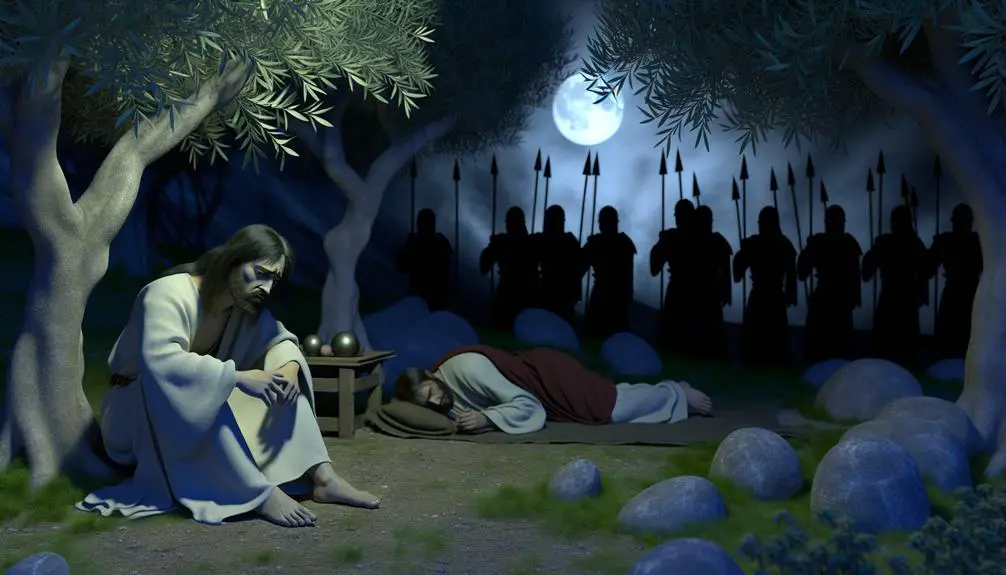
As you explore the events leading to the crucifixion, it's critical to examine the Last Supper, where Jesus shared final teachings and identified His betrayer. This intimate gathering sets the stage for the ensuing betrayal and arrest, pivotal moments that catalyze the culmination of His earthly ministry. By analyzing these sequences, you'll gain insights into the complex interplay of loyalty, prophecy, and destiny that shapes this central narrative of Christian theology.
Last Supper Details
Before delving into the crucifixion, it is crucial to examine the Last Supper, where Jesus shared significant final teachings and instituted the Eucharist with His disciples. During this pivotal meal, every element held deep symbolism. The bread, broken by Jesus, symbolized His body soon to be sacrificed. The wine, poured out and shared, represented His blood, signifying the new covenant between God and humanity. This meal wasn't just a somber event; it was a profound establishment of communion, deeply impacting the disciples. Their reactions ranged from confusion to awe, struggling to grasp the full implications of the rites and the impending sacrifice. This moment underscored their transformation from followers to bearers of Jesus' teachings to the world.
Betrayal and Arrest
Following the Last Supper, Jesus' impending crucifixion was set into motion by Judas Iscariot's betrayal, which led directly to His arrest. You might wonder about Judas' motivation. Scholarly interpretations suggest a mix of disillusionment and financial gain, but some posit deeper theological or eschatological reasons, believing Judas aimed to force Jesus into a position where He would assert His messianic role more aggressively. The arrest itself was markedly influenced by Roman involvement. The Sanhedrin, the Jewish council, needed the Roman authorities to execute a death sentence, as they lacked the legal autonomy to impose capital punishment. Therefore, Judas' betrayal was not merely a personal failing but a catalyst within a larger socio-political and religious framework, intertwining divine prophecy and earthly governance.
The Significance of Golgotha
Golgotha, often referred to as the place of the skull, emblematically symbolizes the culmination of Christ's earthly ministry and the fulcrum of Christian redemption. You might wonder why this particular site was chosen for such a pivotal event. The geographical location of Golgotha, just outside Jerusalem's walls, accessible yet separate, underscores its symbolic interpretations. It served not only as a place of execution but also as a stark reminder of mortality and condemnation under Roman law.
Delving deeper, the name 'Golgotha' itself holds layers of symbolism. It's believed to derive from Aramaic roots meaning 'skull', suggesting a site of death but also echoing the Genesis prophecy of the 'seed of the woman' crushing the serpent's head. This resonance with Old Testament themes underscores the messianic fulfillment you see in Jesus' crucifixion.
Moreover, located at a crossroads, Golgotha was a place of public spectacle, ensuring that Jesus' death was widely witnessed, fulfilling the scriptural mandate that the Messiah would be a sign to the people. This visibility meant that the impact of Christ's sacrifice was not confined to a secluded area but was instead a profound public attestation to divine love and justice, reaching an audience far beyond the immediate spectators.
The Tomb: A Detailed Analysis
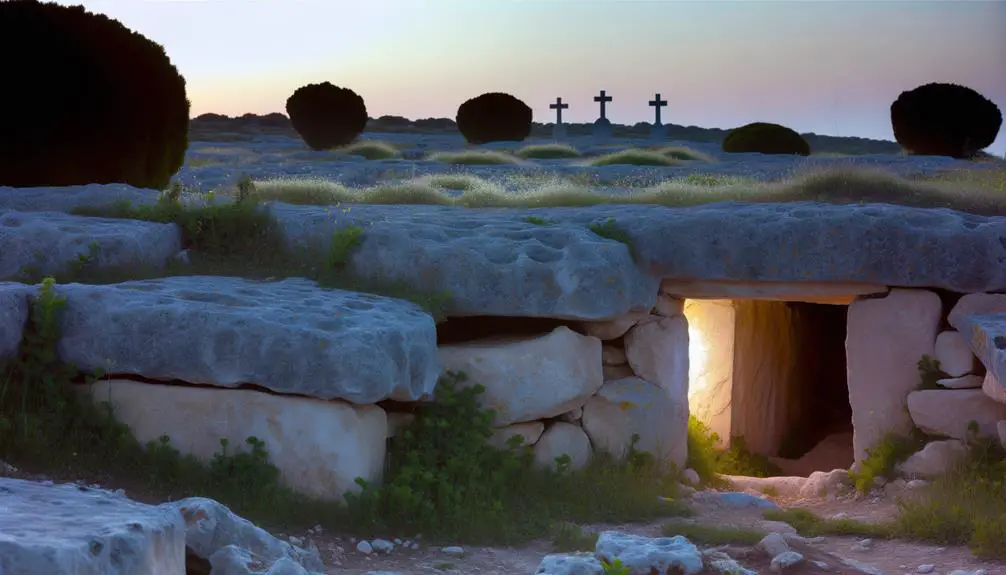
In examining the tomb where Jesus was laid to rest, one must consider not only its physical structure but also its profound theological significance. The tomb, typically envisioned as a cave with a stone rolled across the entrance, reflects both humble and royal undertones—symbolic of Jesus's ministry and the paradox of his kingship. Tomb architecture in first-century Judea generally comprised a small chamber carved from rock, intended for the body's natural decomposition. This setup further elucidates the narrative of Jesus's resurrection, emphasizing the physical and miraculous nature of his rising, as the stone barrier and the sealed enclosure testify to the absence of tampering.
Furthermore, the deployment of guards at the tomb is a critical aspect often underscored in scriptural accounts. The Roman or temple authorities' decision to place guards speaks to the political and religious tensions surrounding Jesus's death. It highlights the concern among leaders that the prophesied resurrection might inspire insurrection or fraud. Analyzing these guards in the context of power dynamics showcases not only the anticipated importance of the tomb's contents but also the fear of Jesus's influence extending beyond his death. This layer of security adds a tangible measure of skepticism and control, framing the resurrection within a milieu of conflict and anticipation.
Witnesses of the Resurrection
Several individuals claimed to have witnessed Jesus's resurrection, each account contributing uniquely to the understanding and interpretation of this pivotal event. These resurrection appearances formed the cornerstone of Apostolic teachings, which you'll find intricately woven through the New Scripture narratives. Initially, Mary Magdalene, according to John 20:14-16, encountered the risen Christ. This moment is significant, not just for its immediate emotional impact but for how it shaped the early Christian witness and proclamation.
Furthermore, in 1 Corinthians 15:5-8, Paul lists Cephas, then the twelve, and subsequently over five hundred others who witnessed Jesus post-resurrection. Each of these accounts plays an important role in the broader scriptural context, emphasizing the tangible reality of Jesus's return from death. This wasn't an abstract theological concept but a lived experience for these first followers.
The resurrection appearances underscore the physicality of Jesus's return, challenging contemporary and later skeptics. By grounding the miraculous in the empirical, these narratives not only bolster the faith of those early Christians but also provide a solid foundation for the propagation of their teachings. Analyzing these appearances helps you appreciate how they reinforced the early Church's mission and substantiated the transformative power of the resurrection story.
Theological Implications
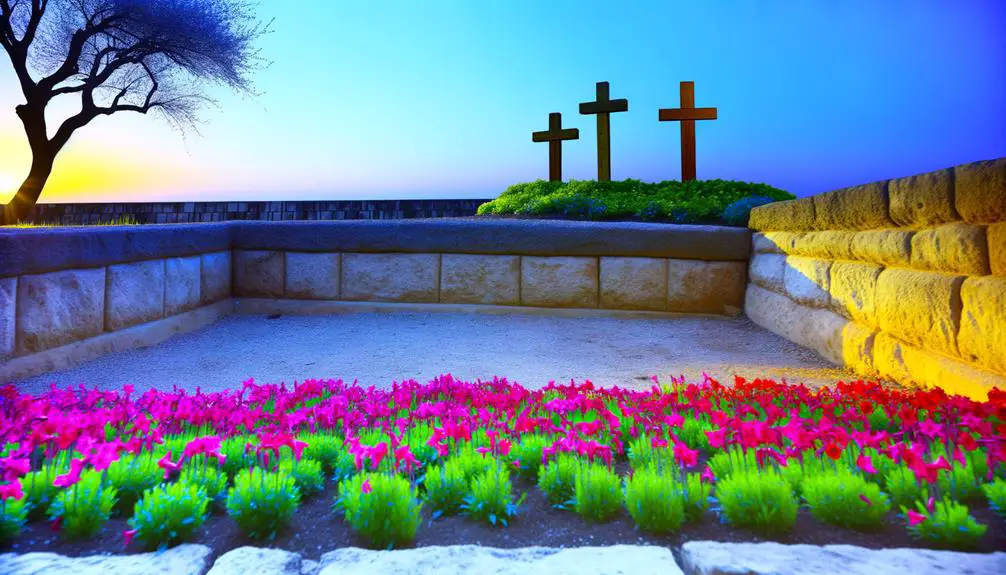
Understanding the resurrection accounts not only confirms the historical reality of these events but also invites you to explore their profound theological implications. The resurrection of Jesus isn't just a miraculous event; it's a cornerstone of Christian theology that embodies the principles of divine justice and the fulfillment of the salvation plan.
In Christian doctrine, divine justice is deeply intertwined with Jesus' death and resurrection. You might wonder how. Well, through His resurrection, Jesus overcomes the wages of sin, which is death, not just for Himself but for all of humanity. This act of rising from the dead validates and seals His role as the mediator between God and man. It's a demonstration that God's justice, which demands a penalty for sin, and His mercy, which spares sinners, are reconciled.
Furthermore, the resurrection is pivotal to the salvation plan. It confirms that Jesus' sacrifice is acceptable to God, powerful enough to defeat death and sin. This assurance is vital for you as a believer; it's the foundation of your hope in eternal life and redemption. Through this lens, the resurrection isn't merely an historical event to be acknowledged, but a transformative experience that offers renewal and hope.
Modern Interpretations and Impact
Modern interpretations of the resurrection greatly influence how you, as a contemporary believer, connect faith with daily life and societal challenges. The narrative isn't just a historical recount; it's woven into the fabric of modern Christianity, affecting ethical decisions and cultural expressions. Here's how:
- Cultural Depictions: Art, literature, and film often explore the resurrection theme, each medium adding layers to its understanding. You've likely seen this narrative portrayed in various forms, from classical paintings to contemporary movies, all of which shape and are shaped by societal norms and values.
- Ethical Implications: The resurrection offers a framework for addressing moral issues. It encourages you to act justly and compassionately, reflecting Jesus' victory over death and injustice. This perspective can guide you in personal and social ethics.
- Educational Influence: Theological education often incorporates modern interpretations of the resurrection to discuss broader philosophical questions about life, death, and purpose. As a student or a lifelong learner, this can profoundly impact your worldview.
- Interfaith Dialogue: Understanding the resurrection in a modern context also facilitates discussions across different religious traditions. It helps you engage in meaningful conversations about life, death, and the afterlife, fostering mutual respect and understanding.
These aspects are important as they help you navigate the complex landscape of contemporary faith, making ancient truths relevant today.
Frequently Asked Questions
How Do Different Christian Denominations Commemorate Jesus' Death and Resurrection?
You'll find that Christian denominations vary in Easter traditions, reflecting liturgical variations. They mark these events with distinct practices, from foot-washing to sunrise services, each embodying unique theological interpretations of these pivotal moments.
Are There Any Archaeological Findings Related to the Crucifixion?
You'll find limited archaeological evidence directly tied to crucifixion artifacts, making historical verifications challenging. Most findings are contextual, derived from period graves or historical texts rather than specific crucifixion sites.
How Do Non-Christian Religions View Jesus' Crucifixion and Resurrection?
You'll find Islamic perspectives deny Jesus' crucifixion, suggesting a substitute was crucified instead. Jewish interpretations generally view these events as non-prophetic and not central to their religious beliefs or theological framework.
What Scientific Explanations Have Been Proposed for the Resurrection?
You're exploring miraculous phenomena, seeking scientific angles. Some theories propose medical anomalies might explain perceived resurrections, analyzing cases where clinical death isn't final. This contextual, scholarly approach considers physiological states mimicking death.
How Has Art Influenced the Perception of the Crucifixion and Resurrection?
Art, like a mirror reflecting societal values, has dramatically shaped our view of iconic events. The iconographic evolution in depictions highlights the symbolic representation, influencing cultural perceptions through various artistic interpretations.

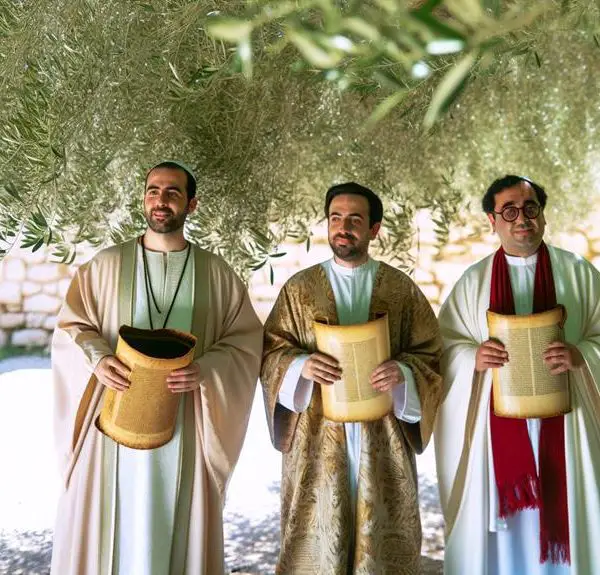
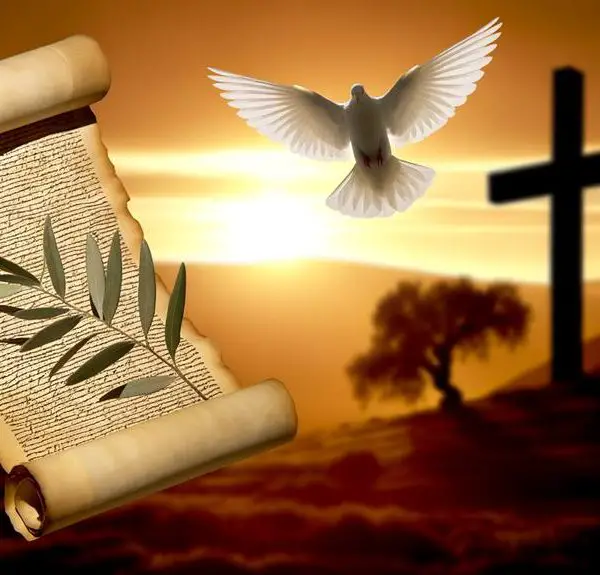
Sign up